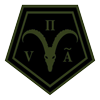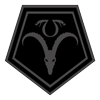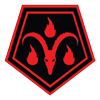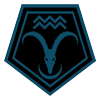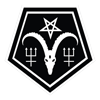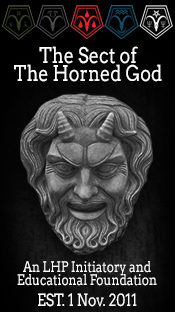Aleister Crowley Goes to Hell: A Short Essay on the Great Beast and the Left-Hand Path
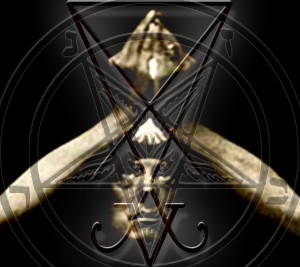
by Paul Fecteau, member of The Sect of the Horned God
The uninitiated have reason to associate Aleister Crowley with satanism. He did, after all, refer to himself as the Beast 666, and it is well known in mainstream culture that 666 has something to do with the Devil, at least if heavy metal lyrics are to be trusted. Indeed, Crowley in the popular imagination amounts to the villain in a slick supernatural horror film–inscrutably he stares, black robe clad, until the orgy scene.
This image of the Great Beast is so pervasive, in fact, that it grips even those ostensibly knowledgeable of the occult. Consequently, one of the most eloquent explicators of Crowley’s ideas, Lon Milo DuQuette, peppers his prose with disclaimers about devil worship. In Understanding the Thoth Tarot, he makes a wide and rather eloquent pitch:
It is understandable that anyone with a Christian background would recoil in horror when he or she first encounters Crowley’s shocking use of words and imagery, such as the Beast 666, Scarlet Woman, All-Father Chaos, Whore of Babylon, or blood of the saints. While these dark ‘blasphemies’ effectively serve to screen out faint-hearted dabblers (and all who choose to remain self-blinded by superstition), they offer a radiant and altogether wholesome spiritual treasure for anyone bold and tenacious enough to do a little research (and a little meditation). (34–5)
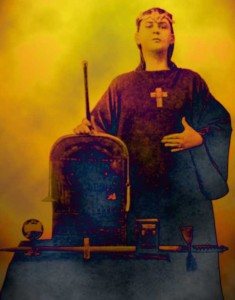
Even for those of us partial to a little Hellfire, DuQuette has a point. Crowley’s writing reflects a mind far too complex to be reduced to any stereotype, let alone that of a debauched diabolist, even if his conduct occasionally fit such a label.
Consider Crowley’s Liber 777, the bulk of which comprises the “Tables of Correspondence,” fifty-some pages of charts, anchored by the Qabalah, cross-referencing the sephiroth with the elements, the zodiac, and the tarot, and concepts far more obscure. It’s the Enigma machine of comparative religion. One imagines a sequestered scholar devoting a chunk of years to such a work, but Crowley prepared it during a week’s stay in Bournemouth, drawing up the charts without benefit of reference material (“Editorial Preface” vi). He intended it as a teaching tool, closing the preface with an encouraging note to students:
Many columns will seem to the majority of people to consist of mere lists of senseless words. Practice, and advance in the magical or mystical path, will enable little by little to interpret more and more (sic). (xvii)
Liber 777 demonstrates Crowley’s encyclopedic knowledge of religious symbolism. For him, mysticism was a language, and he became its poet laureate.
The Great Beast’s inexhaustible vocabulary is not, however, in itself, sufficient to explain his adoption of a demonic moniker. The fire-and-brimstone preachers to whom he was subjected in his youth had an impact on him, but he was not of their ilk. He took on the title of Master Therion in an echo of the Book of Revelation because he saw himself as the initiator of a new aeon which would wipe away the bluster of the bible-thumpers.
These days, it’s run of the mill to have a scary pseudonym, particularly online. Though few of those who do are any more like a cartoonish devil-worshipper than Crowley was, many do identify as satanists. It is, therefore, worth noting that Crowley did not. In fact, in the last chapter of “Magick in Theory and Practice,” he specifically dismissed both black magic and the left-hand path, treating each as a distinct misstep.
As we would expect, Crowley avoids the facile definition of “black magic” as done for naughty purposes, seeing it instead as done without legitimate purposes, legitimacy defined by his elaborate cosmology, at the core of which is the maxim “Do what thou wilt shall be the whole of the law.” Oft quoted but just as often misunderstood, the line ranks as one of his ideas that have been regarded as infernal. Crowley wasn’t endorsing carnality, per se, but pronouncing that each individual has a purpose that if pursued will bring fulfillment and if denied will result in futility. Using occult knowledge to do other than one’s Will ranks as “black magic” in Crowley’s book, and that definition explicitly includes all the clichés of the New Age movement: “Christian Scientists, Mental Healers, Professional Diviners, Psychics and the like, are all ipso facto Black Magicians” (Magick 276).
Sorting through the caveats and footnotes to the caveats, typical of Crowley’s dense style, it becomes clear that acts traditionally defined as “evil” do not in all cases meet the definition of black magic. Crowley includes an anecdote about an adept who “found it necessary to slay a Circe who was bewitching brethren” (Magick 279). This man crept to the woman’s bedroom door and thereon carved an “Astral T (traditore, and the symbol of Saturn) with an astral dagger” and “within 48 hours she shot herself” (Magick 279).
Crowley’s rejection of the left-hand path is less fraught with random oddity but just as dependent on his complicated system, specifically the advanced stage of initiation via which one becomes a Master of the Temple. Doing so entails surviving the Horror of the Abyss during which the self is annihilated and the adept achieves synchrony with the universe. Those whom Crowley terms “the Black Brothers” advance to the abyss but there refuse to surrender their blood to Babalon’s cup (Magick 276-7); in other words, treaders of the left-hand path insist on their individuality and avoid any spiritual assimilation. Conceptually, such a definition of the left-hand path would likely appeal to any modern satanist, even if Crowley claims they will ultimately wind up “shreds strewn in the abyss” (Magick 277).
In particular, it would seem that contemporary theistic Satanists would be engaged not only by thumbing their noses at the Horror of the Abyss but by Crowley’s supernatural trappings. The Temple of Set’s founder, Dr. Michael Aquino, whom Setians refer to as the Second Beast, picks up on Crowley’s implication that initiates travel one path — no left hand or right hand to it — until the Ordeal of the Abyss, and Aquino argues that remains true afterwards:
The inevitable conclusion is that there is no Right-Hand Path to the initiatory level of Magister Templi. . . . There is only the Left-Hand Path, and it is fraught with danger — not a one-time crossing of the Abyss test, but a continuous peril that exists from the moment the individual completely realizes him-Self as a Magister. (qtd. in Flowers 147)
In that case, it would seem that Crowley was one of the Black Brothers all along — he just didn’t realize it.
If you are waiting for Satan to jump out of that inky abyss, you are out of luck. In that same chapter on black magic, Crowley proclaims, “The Devil does not exist. It is a false name invented by the Black Brothers to imply a Unity in their ignorant muddle of dispersions” (Magick 277). Atheistic satanists, of course, knew this all along and should not shy away from Crowley. At least, we ought to be able to summon a little more intellectual backbone than the right-hand pathers who ignore DuQuette’s appeals as they browse in New Age bookstores that also sell yoga mats. Indeed, anyone willing to engage Crowley’s occult universe as operant in the psyche of each individual stands to gain from study of his writing, provided there is also a willingness to forge on when confronted by those darkest of spaces that make us human.
Works Cited
Crowley, Aleister. 777 Revised. 1909. Leeds: Celephaïs Press, 2006.
___, Magick (Liber ABA: Book Four). 1913. San Francisco: Weiser, 2008.
DuQuette, Lon Milo. Understanding Aleister Crowley’s Thoth Tarot. San Francisco: Weiser, 2003.
Flowers, Stephen E. Lords of the Left Hand Path: A History of Spiritual Dissent. Smithville, TX: Rûna-Raven, 1997.
